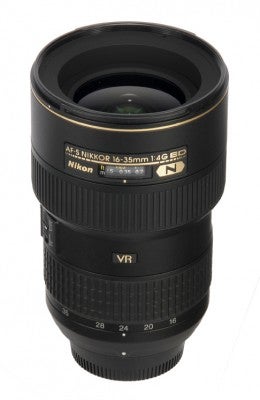This new lens, the Nikon 16-35mm, is the world’s first ultra-wide zoom to offer vibration reduction (VR-II) technology. The What Digital Camera Nikon AF-S 16-35mm f/4G review finds out how it fares
Nikon AF-S 16-35mm f/4G ED VR Review
The most obvious thing about this lens, however, is its quietness: it really is virtually silent in AF mode. It is also very quick and focuses both accurately and reliably. Manual intervention can be used in AF mode but there was no occasion when it was needed during testing. The focusing ring is foremost but it remains static in AF mode so there is no need to adopt a compromised grip.
Zooming is carried out using the rearward ring, which would be awkward were it not for the fact that it is generously wide and can be gripped without needing a double-jointed third finger. Slider switches that change from AF/MF to MF and activate the VR system are located between the two rings and fall very comfortably under the user’s thumb.
Although the rings are rubberised the lens barrel itself has a satin texture that feels a little slippery. Nikon describes this lens as ‘a superb option for photographers on a budget’ but it still commands a four-figure price and deserves not to slip through fingers onto the floor.
Optically, Nikon’s 16-35mm f/4 is an absolute stunner. There is no chromatic aberration visible at 16mm and the tiny traces that can just be detected in technical images at 24mm and 35mm are totally insignificant in practice. Similarly, the zoom’s MTF curves are tightly grouped and never dip below the critical 0.25 cycles-per-pixel threshold.
Some potential buyers may object to the fact that the aperture opens only to f/4 but the viewfinder image is bright and the addition of vibration reduction more than compensates for this limitation in all respects except when the narrowest depth-of-field is required. If a faster aperture is truly indispensable then Nikon also offers a 17-35mm f/2.8 lens but at a significantly higher price and without the benefit of vibration reduction.
Nikon MTF Graph (see full quality here)

There is absolutely nothing to fault in these curves, which indicate an exceptionally well-matched and consistent set of results.
Nikon Wide (see full quality here)

There is a very slight hint of chromatic aberration around the branches in the top corner of this picture but it is invisible unless sought at high magnification.
Nikon Tele (see full quality here)

There is good visual sharpness on the centre-most corner of the roof and a smooth transition into out-of-focus areas until pixellation takes over at high magnification.





